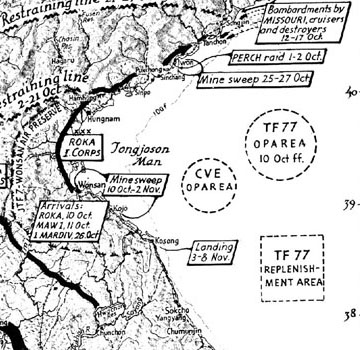|

DEPARTMENT OF THE NAVY -- NAVAL HISTORICAL
CENTER
Of
the numerous islands in the Bay of Wonsan, UN forces eventually
occupied and used seven: Yo-do, Mo-do, Sa-do, Sin-do, Tae-do,
Ung-do, and Hwangto-do. The first island captured was Sin-do.
Yo-do
was approximately 2,500 yards long and 1,500 yards wide, with
an elevation of 377 feet. One cove and beach, suitable for
landing, were located on the western side of the island. Nearby
was the tiny fishing village of Yodo-ri, with a population
of some 70 men, women, and children. The town consisted of
several huts and one school. The size, location, and topography
of Yo-do made it an ideal base for implementing the siege.
In mid-March, the Communists made an attempt to make a sampan
landing on Tae-do, but were driven off by gunfire from the
destroyers. Three days after this attempt, 24 March 1951,
the U. S. destroyer English (DD-696) (CDR R. J. Toner) landed
a shore fire control party on Tae-do. Except for a leper colony
of one hundred fifty people, Tae-do was not occupied. The
island was also the site of a former Japanese fort, and lay
even closer to Wonsan. On the following day, the cruiser Saint
Paul and four destroyers, including the USS English, fired
on targets in Wonsan with good results, their gunfire being
corrected by the spotters on Tae-do.
Operating from Yo-do, the Korean marines gradually expanded
control over several other islands in the bay: Mo-do, So-do
and Hwangto-do. The latter island was the best spotting and
observation post of all.
The first naval officer assigned to the Wonsan harbor islands
was LT James S. Lampe, Jr., an intelligence officer from the
staff of Commander Task Force 95. Lampe, the son of Presbyterian
missionary parents, spoke fluent Korean having been born in
Korea and having lived there for eighteen years.
"I landed on the island of Yo-do on 13 June 1951, with
orders to report to CTG 95.2," said Lampe. "At this
time, we held and were using five of the harbor islands: Yo-do,
Hwangto-do, Sa-do, Mo-do, and Sin-do. By far, the most important
were Yo-do, our base island, and Hwangto-do our naval gunfire
spotting island. (Jim Lampe is the one that took me into Hwangto-do)
next
page
|
 "The
Fightin' Floyd B"
"The
Fightin' Floyd B"

